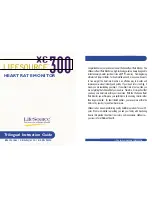
3 Prevention of Electrostatic Discharge (ESD) to
Electrostatically Sensitive (ES) Devices
Some semiconductor (solid state) devices can be damaged easily by static electricity. Such components commonly are called
Electrostatically Sensitive (ES) Devices. Examples of typical ES devices are integrated circuits and some field-effect transistors and
semiconductor "chip" components. The following techniques should be used to help reduce the incidence of component damage
caused by electrostatic discharge (ESD).
1. Immediately before handling any semiconductor component or semiconductor-equipped assembly, drain off any ESD on your
body by touching a known earth ground. Alternatively, obtain and wear a commercially available discharging ESD wrist strap,
which should be removed for potential shock reasons prior to applying power to the unit under test.
2. After removing an electrical assembly equipped with ES devices, place the assembly on a conductive surface such as
aluminum foil, to prevent electrostatic charge buildup or exposure of the assembly.
3. Use only a grounded-tip soldering iron to solder or unsolder ES devices.
4. Use only an anti-static solder removal device. Some solder removal devices not classified as "anti-static (ESD protected)" can
generate electrical charge sufficient to damage ES devices.
5. Do not use freon-propelled chemicals. These can generate electrical charges sufficient to damage ES devices.
6. Do not remove a replacement ES device from its protective package until immediately before you are ready to install it. (Most
replacement ES devices are packaged with leads electrically shorted together by conductive foam, aluminum foil or comparable
conductive material).
7. Immediately before removing the protective material from the leads of a replacement ES device, touch the protective material
to the chassis or circuit assembly into which the device will be installed.
Caution
Be sure no power is applied to the chassis or circuit, and observe all other safety precautions.
8. Minimize bodily motions when handling unpackaged replacement ES devices. (Otherwise
hamless
motion such as the brushing
together of your clothes fabric or the lifting of your foot from a carpeted floor can generate static electricity (ESD) sufficient to
damage an ES device).
6
TH-37PR10U / TH-42PR10U
Summary of Contents for TH-42PR10U
Page 4: ...1 Applicable signals 4 TH 37PR10U TH 42PR10U ...
Page 28: ...8 1 2 Lead wiring 2 The lead wiring is dressed as shown in figure 28 TH 37PR10U TH 42PR10U ...
Page 29: ...8 1 3 Lead wiring 3 The lead wiring is dressed as shown in figure 29 TH 37PR10U TH 42PR10U ...
Page 31: ...8 2 2 Lead wiring 2 The lead wiring is dressed as shown in figure 31 TH 37PR10U TH 42PR10U ...
Page 32: ...8 2 3 Lead wiring 3 The lead wiring is dressed as shown in figure 32 TH 37PR10U TH 42PR10U ...
Page 35: ...9 4 Adjustment Volume Location 9 4 1 TH 37PR10U 9 4 2 TH 42PR10U 35 TH 37PR10U TH 42PR10U ...
Page 36: ...9 5 Test Point Location 9 5 1 TH 37PR10U 9 5 2 TH 42PR10U 36 TH 37PR10U TH 42PR10U ...
Page 40: ...10 2 IIC mode structure following items value is sample data 40 TH 37PR10U TH 42PR10U ...
Page 42: ...42 TH 37PR10U TH 42PR10U ...
Page 44: ...44 TH 37PR10U TH 42PR10U ...
Page 49: ...13 Option Setting 49 TH 37PR10U TH 42PR10U ...
Page 78: ...NOTE TH 37PR10U TH 42PR10U 78 ...
Page 79: ...15 Block and Schematic Diagram 15 1 Schematic Diagram Notes TH 37PR10U TH 42PR10U 79 ...
Page 137: ...16 Parts Location 16 1 Exploded View 16 1 1 TH 37PR10U 137 TH 37PR10U TH 42PR10U ...
Page 138: ...16 1 2 TH 42PR10U 138 TH 37PR10U TH 42PR10U ...
Page 140: ...16 2 Cable relation 16 2 1 TH 37PR10U 16 2 2 TH 42PR10U 140 TH 37PR10U TH 42PR10U ...
Page 141: ...16 3 Accessories Box 141 TH 37PR10U TH 42PR10U ...
Page 143: ...18 Replacement Parts List 18 1 Relpacement Parts List Notes 143 TH 37PR10U TH 42PR10U ...







































